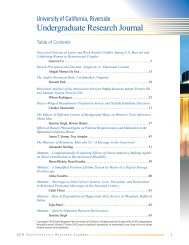2010 - Undergraduate Research, Scholarship and Creative Activity
2010 - Undergraduate Research, Scholarship and Creative Activity
2010 - Undergraduate Research, Scholarship and Creative Activity
You also want an ePaper? Increase the reach of your titles
YUMPU automatically turns print PDFs into web optimized ePapers that Google loves.
The Sexualized African American Woman<br />
Abie Irabor, Media <strong>and</strong> Cultural Studies<br />
Mentor: Caroline Tushabe<br />
Department of Women‘s Studies<br />
This paper examines how the over sexualization<br />
of African American women in the media<br />
further marginalizes them in society. African<br />
American women have been portrayed in music<br />
videos, movies <strong>and</strong> even advertisement<br />
magazines as sexual beasts <strong>and</strong> women without<br />
sexual control. Given the historical construction<br />
of African American bodies, African American<br />
communities <strong>and</strong> individuals have, since the<br />
Civil Rights Movement, made great strides in<br />
society to create a positive image of their<br />
communities, individual selves <strong>and</strong> work ethics.<br />
However, there are persistent negative images of<br />
African American women which lead one to ask:<br />
―How much voice <strong>and</strong> decision-making power<br />
do African American women who participate in<br />
the industry have about their images in the<br />
entertainment industry?‖ What factors or what<br />
steps can African American women in the entertainment<br />
industry deploy to put an end to the<br />
negative portrayal of African American<br />
women‘s bodies as sex objects? What analytical<br />
<strong>and</strong> theoretical processes can bring the African<br />
American woman out of invisibility within<br />
society‘s margins to that of self-making, power,<br />
<strong>and</strong> free persons? Does the responsibility lie<br />
with only African American women or community,<br />
or the whole of society? My goal is to<br />
analyze rap music videos, movies <strong>and</strong> magazines<br />
to illuminate the relations between mainstream<br />
conditions of conformity to masculinity <strong>and</strong><br />
femininity <strong>and</strong> the sexual exploitation of African<br />
American women in the media <strong>and</strong> their<br />
marginalization in society.<br />
Photochemical Disinfection of Pathogens:<br />
Role of Bacterial Extracellular<br />
Polymeric Substances (EPS) Coverage<br />
Parham Javadinajjar, Chemical Engineering<br />
Contributor: Amy Gong<br />
Mentor: Sharon L. Walker, Department of<br />
Chemical <strong>and</strong> Environmental Engineering<br />
This project is intended to determine the effects<br />
of natural constituents present in agricultural<br />
run-off waters <strong>and</strong> the effect of extracellular<br />
polymeric substances (EPS) found on E. coli on<br />
sunlit photochemical disinfection of waterborne<br />
pathogens, which can have health <strong>and</strong><br />
environmental risks. A series of batch scale<br />
experiments were completed or still in progress<br />
to validate the effect of nitrate as reactive<br />
oxygen species (ROS) producer, specifically<br />
hydroxyl radicals (•OH), <strong>and</strong> the role of EPS. E.<br />
coli in mid-exponential growth phase with<br />
varying levels of EPS, removed by ultra<br />
sonication, were then placed in either a dark<br />
environment or under a solar simulator (450 W<br />
xenon lamp <strong>and</strong> 305nm cut-on filter), which<br />
allows wavelength over 305nm to penetrate in<br />
the solutions with several different<br />
concentrations of nitrate. The survival rate of<br />
the bacteria was determined microscopically<br />
every 15 minutes using a Live/Dead BacLight<br />
Bacterial Viability kit. Time versus survival rate<br />
was plotted for each experiment. Current results<br />
from bacteria with different EPS level in dark<br />
<strong>and</strong> light control, <strong>and</strong> in nitrate solutions,<br />
suggested that both nitrate <strong>and</strong> disruption of EPS<br />
increase the rate of disinfection. Cells which<br />
have been exposed to more intense sonication<br />
have a larger proportion of EPS removed which<br />
corresponds to a higher rate of die off in the<br />
presence of nitrate. Conversely, the slower rate<br />
of die-off in the presence of more EPS suggests<br />
that it protects the bacteria from ROS or have<br />
scavenging ability. More experiment will be<br />
conducted in the presence of dissolved organic<br />
matter (DOM) solution in the future, <strong>and</strong> it is<br />
anticipated that more visible light will be<br />
absorbed with DOM but less ROS formed than<br />
in the presence nitrate. The influence of EPS<br />
level on the bactericidal activity <strong>and</strong> their<br />
interactions with other ROS (such as O 2 , H 2 O 2 ,<br />
O •- 2 ) will also be investigated.<br />
Fourth Annual UCR Symposium for <strong>Undergraduate</strong> <strong>Research</strong>, <strong>Scholarship</strong> <strong>and</strong> <strong>Creative</strong> <strong>Activity</strong><br />
34














